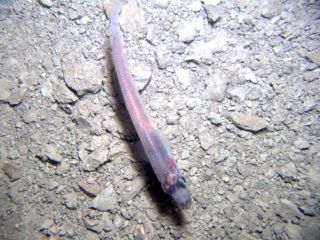Surprise! Fish Lurk in Antarctica's Dark Underworld

In a cold and dark underwater world, where a never-ending rain of rocks keeps the seafloor barren, researchers were startled to find fish, crustaceans and jellyfish investigating a submersible camera after drilling through nearly 2,500 feet (740 meters) of Antarctic ice.
The swimmers are in one of the world's most extreme ecosystems, hidden beneath the Ross Ice Shelf, roughly 530 miles (850 kilometers) from the open ocean. "This is the closest we can get to something like Europa," Slawek Tulaczyk, a glaciologist at the University of California, Santa Cruz and a chief scientist on the drilling project, said, referring to Jupiter's icy moon.
This is the first time scientists have drilled through an ice shelf to its grounding line. These thick, floating tongues of ice are attached to glaciers or ice sheets, and the grounding line marks the transition from land to sea. Researchers with the Whillans Ice Stream Subglacial Access Research Drilling (WISSARD) project punched through the ice with a custom hot-water drill on Jan. 8 and discovered the marine life on Jan. 16. The WISSARD drillers are crunching through the ice with the same setup used to reach Antarctica's subglacial Lake Whillans in 2013, when scientists grabbed the first evidence of microbial life from a lake under the ice sheet. [Life on the Edge: Photos from Drilling the Ross Ice Shelf ]
A remotely operated camera revealed the curious fish and amphipods, a type of crustacean that thrives in the ocean's harshest environments. For these translucent pink fish, which are about 8 inches (20 centimeters) long, this location is the farthest south they have ever been found, expedition scientists said. But the rocky seafloor was devoid of life. Tulaczyk said he thinks rocks that are constantly melting out of the ice sheet are responsible for the desolate conditions. Glacial ice can carry dust that is finer than flour or boulders bigger than buses.
"Forms of life that are sedentary will be stoned to death," he told Live Science from McMurdo Station in Antarctica. "The only things that can successfully explore food resources are things that can swim."
Yet the debris may also deliver much-needed nutrients — scarce in this dark, plankton-free world — in the form of ancient, carbon-rich marine sediments. For instance, ice cores brought up from the borehole contained shells called diatoms, the remains of microscopic marine creatures that lived and died before Antarctica froze over. "It could be we're looking at an old ecosystem eroding from the ice," Tulaczyk said.
Life at the grounding line is limited to about 33 feet (10 m) of freedom between the ice and seafloor, in seawater about 28 degrees Fahrenheit (minus 2 degrees Celsius). The drillers had hoped to find the outflow from Lake Whillans but saw no evidence of estuary-like brackish water, Tulaczyk said.
Sign up for the Live Science daily newsletter now
Get the world’s most fascinating discoveries delivered straight to your inbox.
The researchers also retrieved samples of the sediment and seawater, to investigate how Antarctica's ice shelves are responding to rising ocean temperatures. Models suggest that Antarctica's floating ice is melting from below as ocean temperatures increase. Because ice shelves hold back glaciers on land, as the shelves shrink, these flowing glaciers may speed up, boosting sea level rise by dropping ice into the ocean more quickly.
The seawater temperature measured at the drill site was warm enough to melt ice, Tulaczyk said. "Just by measuring the seawater properties, we will be able to verify the theoretical predictions people have been making for decades now," he said. "I think this will be the reference point for what the conditions are at grounding lines. I'm quite confident that it's not representative of every place, but it establishes a baseline."
The discovery of life in the grounding zone marks the end of WISSARD's six-year endeavor in Antarctica, one of the largest glaciological experiments ever sponsored by the National Science Foundation.
Follow Becky Oskin @beckyoskin. Follow Live Science @livescience, Facebook & Google+. Originally published on Live Science.

